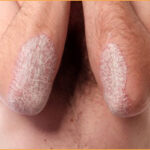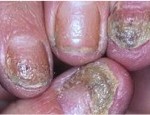The 7 Main Types Of Psoriasis
There are several types of psoriasis — in fact, more than a dozen. If you’ve ever had psoriasis, you know what it’s like to have red, itchy, scaly skin, and you may be familiar with the type of psoriasis you have. But do you know what type of psoriasis you really have?
Were you even aware there was more than just one type of psoriasis? Probably not unless your skin specialist explains the different types to you. There are, in fact, seven main types of psoriasis, and although the basic symptoms are the same, they are all a little bit different and affect people in different ways.
All forms of psoriasis primarily affect the skin. They can cause a few different problems, and if you are lucky, they will only cause one problem at a time. Psoriasis is infamous for causing redness, itching, flaking, shedding, and even cracking and bleeding of the skin. It’s less famous for causing nail loss, pustular infections, an sunburn-like rash and even increased blood pressure, chills and fever.
The skin has two epidermal skin layers, the top and the bottom layer. The top layer is the older skin; it lasts for a few weeks and then begins to shed off on its own. The bottom layer is the new skin growth that takes over for the shedding skin. Shedding skin is a perfectly normal procedure, but it happens slowly over time so that we don’t notice.

In psoriasis, however, the bottom layer tries to move up to the top before the top is ready to shed. This leaves cracks in the skin and gives it that red, cracked, and flaky look. On top of that, the skin may start to become dry, irritated, and painfully inflamed.
If you scratch at the skin while it is flaky, red, and peeling, you could get weeping lesions and scaling on the affected area. Most are uncomfortable, especially when you take a bath or shower.
The seven main types of psoriasis are plaque psoriasis, guttate psoriasis, inverse psoriasis, pustular psoriasis, erythrodermic psoriasis, nail psoriasis, and psoriatic arthritis. Let’s now describe them in a little more detail, click on the links for more detailed information.

Plaque Psoriasis
Plaque Psoriasis
Plaque Psoriasis is the most common type of the disease, and it is one most people are familiar with. It has been estimated that as many as one in ten who have psoriasis have plaque psoriasis. Each person is different, but for the most part, it appears as patchy, thick, flaky skin that causes itching and inflammation. If the damaged skin gets injured in some way, it is easily infected. This form of psoriasis is common on the scalp, legs, arms, and torso. If you have psoriasis, chances are you probably have plaque psoriasis, which is the most common form of psoriasis and the form I would most regularly see in my clinic.

Guttate Psoriasis
Guttate Psoriasis
Guttate Psoriasis mainly affects children and young adults. It often follows a bout of strep throat or other infections and causes red bumps on the skin. This form is often misdiagnosed as an allergic reaction rash or a fever rash. The good news is that in most cases, guttate psoriasis can clear up entirely when treated with herbs or dietary supplements that inhibit or kill bacteria, and it almost never comes back. Just like plaque psoriasis, I’ve had success with guttate psoriasis using the Psoriasis Program methods developed over a long period of time..

Inverse Psoriasis
Inverse Psoriasis
Inverse psoriasis is a type of psoriasis that appears in areas where your skin rubs against itself (skin folds), including the armpits (axilla), belly button (navel), below your breasts, and in the groin region. It looks like a shiny, smooth, discoloured (brown, red, or purple) rash, and it may feel damp. This particular form of psoriasis affects certain areas of your body, notably the crease of the neck, the armpits, beneath the breasts, between the buttocks, in the groin region, around the penis, scrotum or vulva, as well as the skin of the inner thighs. It has been estimated that between 3% and 7% of those with psoriasis also have inverse psoriasis.

Pustular Psoriasis
Pustular Psoriasis
Pustular psoriasis affects mainly older people, and about 3 percent of people who have psoriasis. Symptoms can be painful and annoying, and include white, pus-filled, painful bumps (pustules) that are often surrounded by reddened/discoloured or inflamed skin. Pustular psoriasis may cover large parts or most of the body, or appear only on certain areas of the body, such as the hands and feet.

Erythrodermic Psoriasis
Erythrodermic Psoriasis
Erythrodermic psoriasis is one of the rarest forms of psoriasis, affecting less than two percent of people who have psoriasis. This type of psoriasis can cause intense redness or discolouration and shedding of skin layers in large sheets. It often affects nearly the whole body and can be life-threatening. some may develop redness and inflammation resembling severe sunburn on over half the surface area of their body. The skin rash is very itchy and may cause a burning sensation. Other symptoms may include changes in heart rate and temperature, dehydration, severe itching and pain, finger or toenail changes or even loss. If an an erythrodermic flare occurs, it is important to see a doctor immediately.

Nail Psoriasis
Nail Psoriasis
Nail psoriasis can affect as many as 40 to 50 percent of those with psoriasis. Most with psoriasis will experience this form of psoriasis to some degree. Nail psoriasis will commonly affect several fingers or toes, and will be more commonly experienced on the nails of the hands than toenails. The most commonly associated nail problems include discolouration of nails (yellow, dark brown), nail thickening or deformation, pitting (tiny holes). A condition called onycholysis may occur, when the nail separates from the nail bed. Painless everyday activities we all take for granted, like opening a jar, or taking a shower, can be an uncomfortable and even painful experience for those with psoriatic nails. This form of psoriasis can be an indication the person also has psoriatic arthritis, also known as PsA.

Psoriatic Arthritis
Psoriatic Arthritis
Nail psoriasis can affect as many as 40 to 50 percent of those with psoriasis. Most with psoriasis will experience this form of psoriasis to some degree. Nail psoriasis will commonly affect several fingers or toes, and will be more commonly experienced on the nails of the hands than toenails. The most commonly associated nail problems include discolouration of nails (yellow, dark brown), nail thickening or deformation, pitting (tiny holes). A condition called onycholysis may occur, when the nail separates from the nail bed. Painless everyday activities we all take for granted, like opening a jar, or taking a shower, can be an uncomfortable and even painful experience for those with psoriatic nails. This form of psoriasis can be an indication the person also has psoriatic arthritis, also known as PsA.



